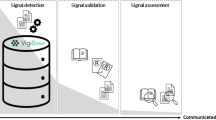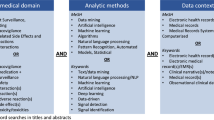Abstract
The General Practice Research Database (GPRD) is the world’s largest computerised database of anonymised longitudinal clinical records from primary care. The database already has an international reputation in the field of drug safety signal evaluation where the results of GPRD-based pharmacoepidemiological studies have been used to inform regulatory pharmacovigilance decision making. The characteristics and richness of the data are such that the GPRD is likely to prove a key data resource for the proactive pharmacovigilance anticipated in risk management and pharmacovigilance plans.
An update of recent developments to the database and new data available from it — including spontaneously recorded suspected adverse drug reactions — is presented in the article, with a description of how the data can be used to support a variety of pharmacovigilance applications. The possibility of using the GPRD in signal detection and assessment of the impact of pharmacovigilance activities in the future is also discussed.





Similar content being viewed by others
References
Waller PC, Evans SJW. A model for the future conduct of pharmacovigilance. Pharmacoepidemiol Drug Saf 2003; 12: 17–29
Risk assessment of observational data: good pharmacovigilance practices and pharmacoepidemiologic assessment. Concept paper [online]. Available from URL: http://www.fda.gov/cder/meeting/groupIIIfinal.pdf [Accessed 2003 Mar 3]
United States Food and Drug Administration. Managing the risks from medical product use: creating a risk management framework [online]. Available from URL: http://www.fda.gov/oc/tfrm/riskmanagement.pdf [Accessed 1999 May]
Establishing a European risk management strategy: summary report of the Heads of Agencies ad hoc Working Group [online]. Available from URL: http://heads.medagencies.org/heads/docs/summary.pdf [Accessed 2003 Jan]
Wood L. GPRD in the UK. In: Mann R, Andrews E, editors. Pharmacovigilance. Chichester: John Wiley & Sons Ltd, 2002: 373–378
Lawson DH, Sherman V, Hollowell J. The general practice research database. Q J Med 1988; 91: 445–52
Garcia Rodriguez LA, Perez-Gutthann S, Jick S. The UK General Practice Research Database. In: Strom BL, editor. Pharmacoepidemiology. Chichester: John Wiley & Sons Ltd, 2000: 375–85
Ryan R, Majeed A. Prevalence of ischaemic heart disease and its management with statins and aspirin in general practice in England and Wales, 1994 and 1998. Health Statistic Quarterly 2001; 12: 34–9
Soriano JB, Maier WC, Egger P, et al. Recent trends in physician diagnosed COPD in women and men in the UK. Thorax 2000; 55: 789–94
van Staa TP, Dennison EM, Leufkens HG, et al. Epidemiology of fractures in England and Wales. Bone 2001; 29: 517–22
Johansson S, Wallander MA, Ruigomez A, et al. Treatment patterns among newly diagnosed heart failure patients in general practice. Eur J Clin Pharmacol 2002; 57: 813–7
Frischer M, Heatlie H, Chapman S, et al. Switching between Metered Dose Inhalers (MDIs) and Dry Powder Inhalers (DPIs) in airways disease: an analysis of age-specific rates using the General Practice Research Database. Appl Ther Res 1999; 2: 253–9
McGuire A, Irwin DE, Fenn P, et al. The excess cost of acute exacerbations of chronic bronchitis in patients aged 45 and older in England and Wales. Value Health 2001; 4: 370–5
Millson DS, Clark W, Ward H, et al. Cost effectiveness of migraine therapy: evaluating new acute treatments using the example of the triptans. In: Goadsby P, Dowson A, Miles A, editors. Key advances in the effective management of headache. London: BMA/Aesculapius Medical Press, 1999
Hajat S, Goubert SA, Haines A, et al. Association of air pollution with daily GP consultations for asthma and other lower respiratory conditions in London. Thorax 1999; 54: 597–605
van Staa TP, Abenhaim L. The quality of information recorded on a UK database of primary care records: a study of hospitalisations due to hypoglycemia and other conditions. Pharmacoepidemiol Drug Saf 1994; 3: 15–21
Steinke D, Evans JMM, MacDonald TM. MEMO in the UK. In: Mann R, Andrews E, editors. Pharmacovigilance. Chichester: John Wiley & Sons Ltd, 2002: 363–71
Lawrenson R, Williams T, Farmer R. Clinical information for research; the use of general practice databases. J Public Health Med, 1999; 21(3): 299–304
Shakir SAW. PEM in the UK. In: Mann R, Andrews E, editors. Pharmacovigilance. Chichester: John Wiley & Sons Ltd, 2002: 333–44
Hassey A, Gerrett D, Wilson A. A survey of validity and utility of electronic patient records in a general practice. BMJ 2001; 322: 1401–5
Davis S, Riebrock S, Rubino A, et al. Auditing the quality of data in the general practice research database [abstract]. Pharmacoepidemiol Drug Saf 2003; 12: S123
Shah AD, Martinez C. An algorithm to derive a numerical daily dose from text dosage instructions in the General Practice Research Database. Pharmacoepidemiol Drug Saf 2003; 12: S60–1
Rubino A. Validation of birth recording and development of a mother-baby link in the FF-GPRD [abstract]. Pharmacoepidemiol Drug Saf 2002; 11: S70
Williams TJ, Martinez C. Linkage of socioeconomic status data to the General Practice Research Database [abstract]. Pharmacoepidemiol Drug Saf 2002; 11: S168
Neutel CI. The status of pharmacoepidemiology in a regulatory environment. Pharmacoepidemiol Drug Saf 2000; 9: 71–4
Abenheim L, Moore N, Begaud B. The role of pharmacoepidemiology in pharmacovigilance. Pharmacoepidemiol Drug Saf 1999; 8: S1–7
Waller P. Pharmacoepidemiology: a tool for public health. Pharmacoepidemiol Drug Saf 2001; 10: 165–72
García Rodríguez LA, Pírez Gutthann S. Use of the UK General Practice Research Database for pharmacoepidemiology. Br J Pharmacol 1998; 45: 419–25
Smeeth L, Hall AJ, Fombonne E, et al. A case-control study of autism and mumps-measles-rubella vaccination using the general practice research database: design and methodology [abstract]. BMC Public Health 2001; 1(1): 2
Kaye JA, del Mar Melero-Montes M, Jick H. Mumps, measles, and rubella vaccine and the incidence of autism recorded by general practitioners: a time trend analysis. BMJ 2001; 322: 460–3
Derby LE, Myers MW, Jick H. Use of dexfenfluramine, fenfluramine and phentermine and risk of stroke. Br J Clin Pharmacol 1999; 47: 565–9
Garcia Rodríguez LA, Jick H. Risk of upper gastrointestinal bleeding and perforation associated with individual nonsteroidal anti-inflammatory drugs. Lancet 1994; 343: 769–72
Jick H, Hall GC, Dean AD, et al. A comparison of the risk of hypoglycaemia between users of human and animal insulins: experience in the United Kingdom. Pharmacotherapy 1990; 10(6): 395–7
Thorogood M, Armstrong B, Nichols T, et al. Mortality in people taking selegiline: observational study. BMJ 1998; 317: 252–4
Jick H, Jick SS, Derby LE, et al. Calcium-channel blockers and risk of cancer. Lancet 1997; 349: 525–8
Lancaster T, Swart AM, Jick H. Risk of serious haematological toxicity associated with the use of chloramphenicol eye drops in a British general practice database [letter]. BMJ 1998; 316: 667
McKeever TM, Lewis SA, Smith C, et al. Siblings, multiple births, and the incidence of allergic disease: a birth cohort study using the West Midlands general practice research database. Thorax 2001; 56: 758–62
Jick SS, Ferris BZ. Anticonvulsants and congenital malformations. Pharmacotherapy 1997; 17: 561–4
Ruigomez A, Garcia Rodriguez LA, Cattaruzzi C, et al. Use of cimetidine, omeprazole and ranitidine in pregnant women and pregnancy outcomes. Am J Epidemiol 1999; 150: 476–81
Barnes J. From E2A to E2E: new ICH topic on pharmacovigilance planning. Reactions 2003; 950: 3–4
Evans SJW, Waller PC, Davis S. Use of proportional reporting ratios (PRRs) for signal generation from spontaneous adverse drug reaction reports. Pharmacoepidemiol Drug Saf 2001; 10: 483–6
Szarfman A, Machado SG, O’Neill R. Use of screening algorithms and computer systems to efficiently signal higher-thanexpected combinations of drugs and events in the US FDA’s spontaneous reports database. Drug Saf 2002; 25(6): 381–92
Bate A, Lindquist M, Edwards IR, et al. A Bayesian neural network method for adverse drug reaction signal generation. Eur J Clin Pharmacol 1998; 54(4): 315–21
Evans S. Statistical methods of signal generation. In: Mann RD, Andrews EB, editors. Pharmacovigilance. Chichester: John Wiley & Sons Ltd, 2002: 273–9
Hauben M, Zhou X. Quantitative methods in pharmacovigilance: focus on signal detection. Drug Saf 2003; 26(3): 159–86
Clark JA, Klincewicz S, Stang P. Overview: spontaneous signalling. In: Mann R, Andrews E, editors. Pharmacovigilance. Chichester: John Wiley & Sons Ltd, 2002: 247–71
Hand DJ, Adams NM, Bolton RJ, editors. Pattern detection and discovery: ESF Exploratory Workshop, London, UK, September 16-19, 2002. New York: Springer-Verlag, 2002
Hand D, Mannila H, Smyth P. Principles of data mining. Cambridge (MA): The MIT Press, 2001
Edwards IR. Adverse drug reactions: finding the needle in the haystack [editorial]. BMJ 1997; 315(7107): 500
Edwards IR, Lindquist M, Bate A, et al. Data mining. In: Mann RD, Andrews FB, editors. Pharmacovigilance. Chichester: John Wiley & Sons Ltd, 2002: 291–300
Lilienfield DE, Nicholas S, Macneil DJ, et al. Violation of homogeneity: a methodologic issue in the use of data mining tools. Drug Saf 2003; 26(5): 363–6
Walker AM, Wise RP. Precautions for proactive surveillance. Pharmacoepidemiol Drug Saf 2002; 11: 17–20
Holm S. Simple sequentially refective multiple test procedure. Scand J Stat 1979; 6: 65–70
Benjamin Y, Hochberg Y. Controlling the false discovery rate: a practical and powerful approach to multiple testing. J R Statist Soc B 1995; 57: 289–300
Martinez C, Davis S, Heeley E, et al. The ‘Drug Allergy and Intolerance’ structured data area: an additional information source of suspected adverse drug reactions (ADRs) in the Full Feature General Practice Research Database (GPRD) [abstract]. Pharmacoepidemiol Drug Saf 2003; 12: S244
Rychetnik L, Frommer M, Hawe P, et al. Criteria for evaluating evidence on public health interventions. J Epidemiol Community Health 2002; 56: 119–27
Seligman PJ. ’Dear Doctor …’ -evaluating the impact of risk communication efforts. Pharmacoepidemiol Drug Saf 2003; 12: 291–3
Hyslop HL, Read HA, Misica DN, et al. Pharmaceutical risk management: a call to arms for pharmacoepidemiology. Pharmacoepidemiol Drug Saf 2002; 11: 417–20
Peachey J. From pharmacovigilance to pharmacoperformance. Drug Saf 2002; 25(6): 399–405
Acknowledgments
No sources of funding were used to assist in the preparation of this manuscript. Both authors are employed by the UK Medicines and Healthcare products Regulatory Agency and work in the Division which manages the General Practice Research Database.
Author information
Authors and Affiliations
Corresponding author
Rights and permissions
About this article
Cite this article
Wood, L., Martinez, C. The General Practice Research Database. Drug-Safety 27, 871–881 (2004). https://doi.org/10.2165/00002018-200427120-00004
Published:
Issue Date:
DOI: https://doi.org/10.2165/00002018-200427120-00004




